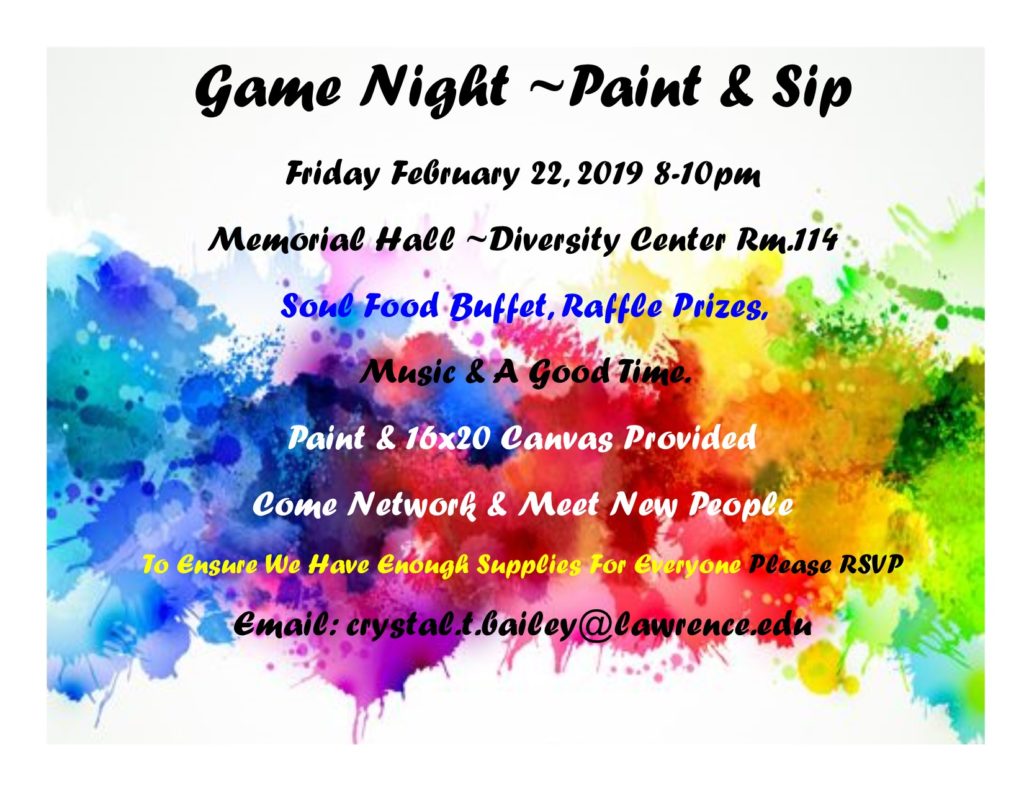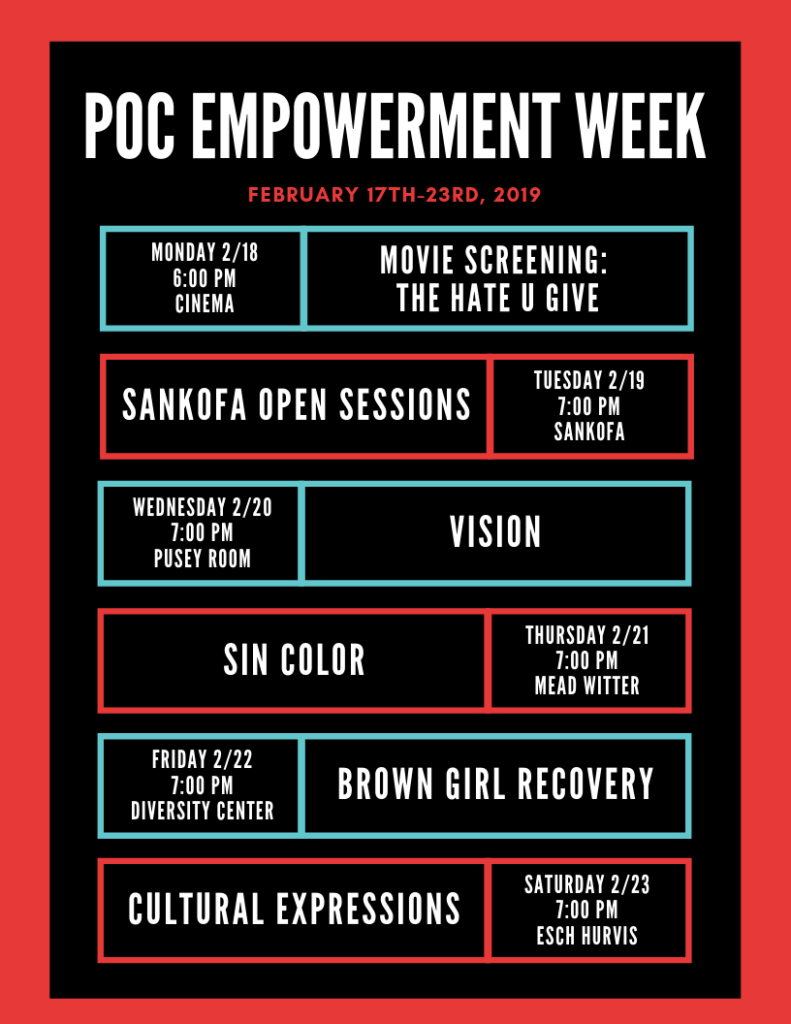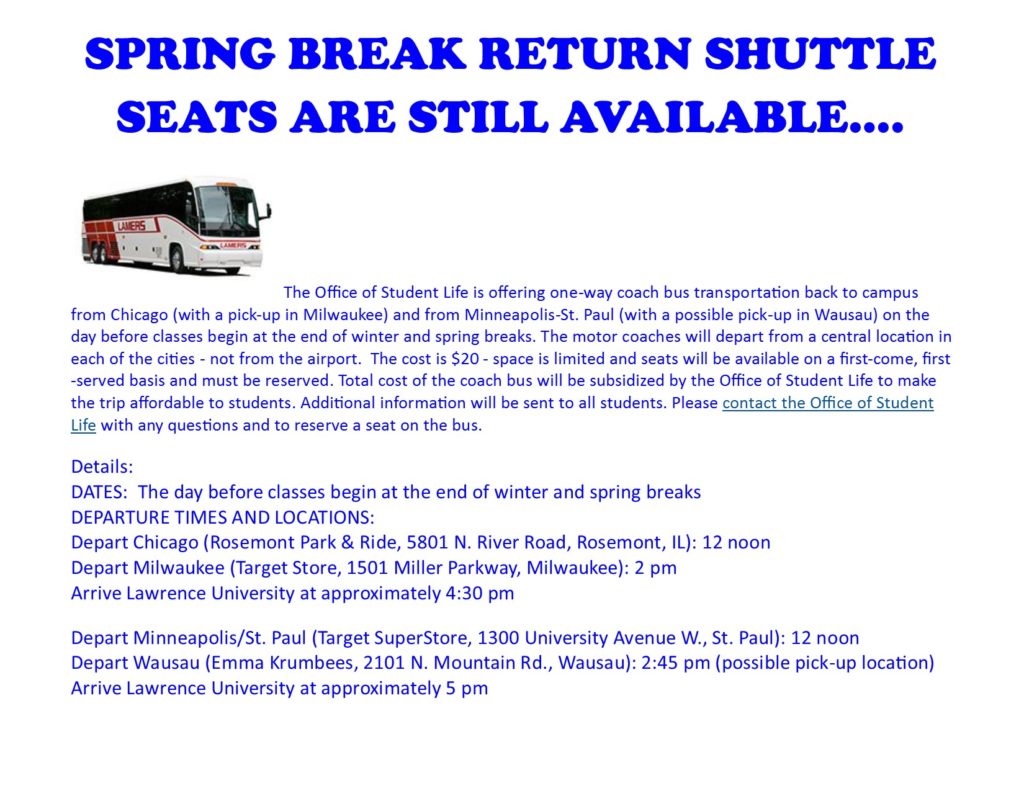On Friday, Feb. 22 from 8-10 p.m., come network and meet new people at Game Night in the Diversity Center. Paint and canvas, soul food buffet, raffle prizes, music and a good time will be included. Please RSVP to crystal.t.bailey@lawrence.edu.


On Friday, Feb. 22 from 8-10 p.m., come network and meet new people at Game Night in the Diversity Center. Paint and canvas, soul food buffet, raffle prizes, music and a good time will be included. Please RSVP to crystal.t.bailey@lawrence.edu.


The Office of Student Life is offering one-way coach bus transportation back to campus from Chicago (with a pick-up in Milwaukee) and from Minneapolis – St. Paul (with a possible pick-up in Wausau) on the day before classes begin at the end of winter and spring breaks. The motor coach will depart from a central location in each of the cities – not from the airport. The cost is $20 – space is limited and seats will be available on a first-come, first-serve basis and must be reserved. Total cost of the coach bus will be subsidized by the Office of Student Life to make the trip affordable to students. Additional information will be sent to all students. Please contact the Office of Student Life with any questions and to reserve a seat on the bus.
Departure Times and Locations:

You are invited to Lunar New Year 2019!
Saturday, January 26 at 6 pm – 8 pm in Warch Campus Center Esch Hurvis
Come celebrate the year of the pig!
Enjoy performances, music, cultural booths, and food!
A two-day dance clinic, February 16th and February 23rd, for students in grades K-8, taught by members of the Lawrence University Dance Team. Students will learn original choreography and will explore how dance can be used as a means for expression.
The first hour will consist of a warm-up and some dance technique, followed by an hour of repertoire, where students will be divided by age to work with LUDT leaders to create a dance. If interested, please email ludanceteam@lawrence.edu by February 2nd to register!
Dear Lawrence Community,
Welcome back to campus and happy new year!
As you may have already a noticed, several changes have been made to the College Avenue pedestrian crossings, as well as surrounding intersections. A new push button-activated warning light system was recently installed in the mid-block crossings on College Avenue. This new system will reduce the number of false activations of the lights and make it clearer to pedestrians when lights are flashing. The crosswalks are also more accessible to the visually impaired thanks to audio beacons at the crossings. In addition, new pedestrian lighting has been added to the southeast corner of College and Lawe Streets and the northeast corner of Lawe and Alton Streets, improving visibility for both pedestrians and drivers.
Even with these improvements, we all must be vigilant when crossing any street, as we are never completely protected from inattentive drivers. As you approach crosswalks or traffic intersections, be sure to pay attention to traffic from all directions, avoid cell phone use and walk briskly while crossing the street, and walk bicycles across intersections.
If you have suggestions, questions, or concerns about pedestrian safety, please direct them to Assistant to the President Jake Woodford (Jacob.a.woodford@lawrence.edu; or 920-832-6850).
Have a wonderful start to the new term.
Sincerely,
Christopher D. Card
Vice President for Student Life
The Office of Student Life is offering one-way coach bus transportation back to campus after Winter Break on Wednesday, January 2, 2019. The cost is $20. Space is limited and seats will be available on a first-come, first-served basis – reservations are needed. Please stop by the Office of Student Life located in Raymond House or send an e-mail to deanofstudents@lawrence.edu with any questions or to reserve a seat.
DEPARTURE TIMES AND LOCATIONS:
Depart Chicago:
O’Hare Tollway Oasis on the Illinois Tollway, Northbound side – 10201 Belle Plaine Ave., Schiller Park at noon
Depart Milwaukee:
Target Store, 1501 Miller Parkway, Milwaukee at 2 p.m.
Arrive at Lawrence University at approximately 4:30 p.m.
Depart Minneapolis/St. Paul:
Target SuperStore, 1300 University Avenue W., St. Paul at noon
Depart Wausau:
The Store, 2409 N. Mountain Rd., Wausau at 3 p.m.
Arrive Lawrence University at approximately 5 p.m
The Office of Student Life is offering one-way coach bus transportation back to campus after Winter Break on Wednesday, January 2, 2019. The cost is $20. Space is limited and seats will be available on a first-come, first-served basis – reservations are needed. Please stop by the Office of Student Life located in Raymond House or send an e-mail to deanofstudents@lawrence.edu with any questions or to reserve a seat.
DEPARTURE TIMES AND LOCATIONS:
Depart Chicago:
O’Hare Tollway Oasis on the Illinois Tollway, Northbound side – 10201 Belle Plaine Ave., Schiller Park at noon
Depart Milwaukee:
Target Store, 1501 Miller Parkway, Milwaukee at 2 p.m.
Arrive at Lawrence University at approximately 4:30 p.m.
Depart Minneapolis/St. Paul:
Target SuperStore, 1300 University Avenue W., St. Paul at noon
Depart Wausau:
The Store, 2409 N. Mountain Rd., Wausau at 3 p.m.
Arrive Lawrence University at approximately 5 p.m
Students, faculty and staff are invited to a “Stop for Your Neighbor” event on November 6, 2018 at 4:45-5:45 PM at the corner of Meade Street and College Avenue. Lawrence in collaboration with the Wisconsin Bike Fed will be educating pedestrians and drivers on the important issue of pedestrian safety.
Please stop by for a few minutes to show your support for better pedestrian awareness.
In addition to small meetings with students, staff and faculty, each candidate will be giving a 30-minute presentation or educational program that advances diversity and intercultural education, which will be followed by a 30 minute Q&A session.
Presentations will be open to the Lawrence community and will all take place in Youngchild 121.
Student meetings are being organized by the committee’s student representative with assistance from the search committee and other campus partners. Check the LU Calendar in the next few days or contact Angelica Hurtado for details on where student meetings will be taking place.
Consider the importance of this role on campus and how your presence at the available meetings and/or presentations can contribute to helping the search team find the best possible candidate for the role.
CANDIDATE 1 – November 5th
CANDIDATE 2 – November 6th
CANDIDATE 3 – November 7th